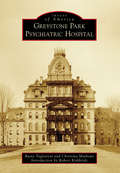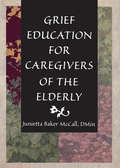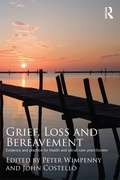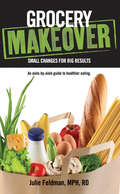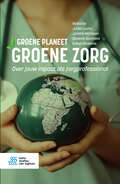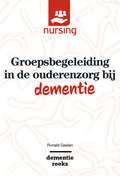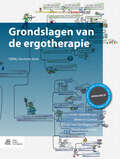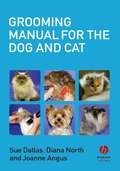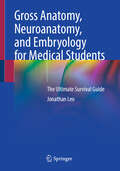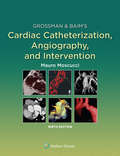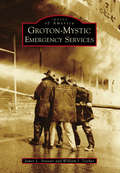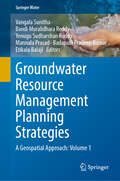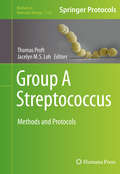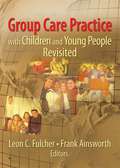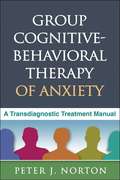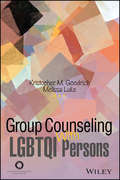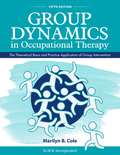- Table View
- List View
Grendel and His Mother: Healing the Traumas of Childhood Through Dreams, Imagery, and Hypnosis (Imagery and Human Development Series)
by Nicholas E. Brink, PhD.One cause of the behavioral, emotional and mental torment in a person's life is the psychological trauma that results from the actions and words of parents and others. This volume, "Grendel and His Mother: Healing the Traumas of Childhood Through Dreams, Imagery and Hypnosis" by Nicholas E. Brink examines the effect of such trauma on a child's development and how the resulting torment eventually brings this child as an adult to psychotherapy. This trauma may be as subtle as a parental sigh of disappointment or as direct as physical or sexual abuse. Six clients are then led on a journeying through the unconscious mind using dream work, hypnosis and imagery in the course of therapy to uncover and heal these traumas to free the client of torment.
Greystone Park Psychiatric Hospital (Images of America)
by Christina Mathews Robert Kirkbride Rusty TagliareniThe Greystone Park Psychiatric Hospital was more than a building; it embodied an entire era of uniquely American history, from the unparalleled humanitarian efforts of Dorothea Dix to the revolutionary architectural concepts of Thomas Story Kirkbride. After well over a century of service, Greystone was left abandoned in 2008. From the time it closed until its demolition in 2015, Greystone became the focal point of a passionate preservation effort that drew national attention and served to spark the public's interest in historical asylum preservation. Many of the images contained in this book were rescued from the basement of Greystone in 2002 and have never been seen by the public. They appear courtesy of the Morris Plains Museum and its staff, who spent many hours digitally archiving the photographs so that future generations may better know Greystone's history.
Grief Education for Caregivers of the Elderly
by Harold G Koenig Junietta B MccallThrough firsthand accounts and research, Grief Education for Caregivers of the Elderly focuses on the education, training, and support of individuals who care for the elderly. This book provides caregivers with methods to cope with grief and loss and will help educators design programs that meet the needs of their consumers: the elderly and their families, friends, and service providers. From Grief Education for Caregivers of the Elderly, you'll learn how to cope with the stress and emotions of caregiving and improve the quality of services to your patients. With an emphasis on caregivers of the institutionalized elderly and the special services provided by clergy, chaplains, and pastoral counselors, Grief Education for Caregivers of the Elderly offers the caregiver or educator several model workshops focusing on grief, loss, and bereavement care. Grief Education for Caregivers of the Elderly contains proven methods and strategies that will sharpen and enhance your caregiving skills, including: focusing on the emotional responses and phases of dying, including denial, anger, and acceptance, to help patients deal with death considering physical and administrative atmosphere and your elderly population when setting goals and designing workshops to provide optimal patient/resident care discussing the themes of grief and loss, stress management, handling change, and promoting self-care for caregivers in workshops and through self-evaluations developing workshops that open with grief history surveys and attitude checklists, discuss normative development and issues of old age, and have themes based on the biological, psychosocial, and spiritual needs of the elderly person providing caregivers with an opportunity to practice what they have learned through case studies, simulated role play, open discussions, and care plan designing thinking about your own mortality and learning about your feelings and ideas of growing oldUtilized at a psychiatric nursing home facility of New Hampshire Hospital, the workshop exercises in Grief Education for Caregivers of the Elderly have allowed caregivers to express personal feelings; talk about beliefs and experiences; learn about biological, psychosocial, and spiritual processes of grief and phases of bereavement; and apply these understandings and insights into typical caregiving situations. Grief Education for the Caregivers of the Elderly gives you the framework for such a program, using vignettes, composite case material, poetry, and a holistic approach to health care to emphasize the importance of your emotional health and enhanced care of the elderly.
Grief, Loss and Bereavement: Evidence and Practice for Health and Social Care Practitioners
by Peter Wimpenny and John CostelloDealing with the social experience of grief, loss and bereavement are challenging areas for everyone, including health and social care practitioners who are often well placed to offer help and support to the bereaved. This book draws together a comprehensive range of worldwide evidence for understanding and supporting the bereaved in a variety of health and social care contexts. It can be used by practitioners from a wide range of backgrounds in both health and social care to gain an appreciation of bereavement and its associated support and care. Additionally, it can be used for personal and professional development by practitioners who want to enhance their own and others’ practice with the bereaved in specific contexts or organisations. The book may also be of value to those undertaking post graduate study who want to gain a wider understanding of the evidence related to bereavement and bereavement care practice in health and social care and may be seeking to add to the body of evidence in this field.
Grief, Loss, and Death: The Shadow Side of Ministry
by Andrew J Weaver Halbert WeidnerLearn to balance the professional demands of your ministry with your personal needsNo amount of research, study, or planning can prepare pastoral care givers for the stress placed on their personal lives by the demands of their ministries. But Grief, Loss, and Death: The Shadow Side of Ministry can help anyone involved in pastoral counseling close the gap between their professional and personal needs, encouraging them to use the stress, loss, and grief that accompanies pastoral care giving as opportunities to humanize their ministries and reaffirm their faith. This unique book offers comfort and solace to those in the chaplaincy who are torn between professional obligations and the limits and boundaries of the shadow side of their ministry-the human side. The shadow side of ministry shoots a bullet through the brain that does not kill or prevent thinking or feeling. But the bullet creates a hole, a long, hollow, empty wound that thinking and feeling must somehow bypass. The wounded minister does not recover the previous self, cannot remember what the old self thought or felt. Like a veteran of a secret war, there may be a new life after the shameful wound, but no public way to heal. But there is a public way of speaking about it and this may help relieve some of the shame and some of the self-blaming.-Author Halbert WeidnerGrief, Loss, and Death: The Shadow Side of Ministry can help in your search for the answers to questions you may have already found yourself asking, including: Do I prefer co-workers or friends? How did I lose focus of my original goals? How did I become isolated? How can I share authority without giving up responsibility? How do I cope when family issues arise?The book also addresses issues of illness, death and suicide, funerals, the confrontation between joy and sorrow, and how life&’s stages are often like the Stations of the Cross. Grief, Loss, and Death: The Shadow Side of Ministry is help against despair. Newcomers to the profession can use the book as a guide to the difficulties that lie ahead, and experienced pastoral care givers can employ it as a catalogue to be consulted when all hope seems lost.
Grocery Makeover
by Julie FeldmanAre your grocery shopping trips less than inspiring? Do you write the same list of items, week after week, and trudge through the store on autopilot? Have you been stocking the same ingredients in your pantry for decades? As you stare at the endless varieties of food on the shelves, do you know how to determine the options that are the most beneficial to your health?.Sounds like you could use a Grocery Makeover!.Let nutritionist Julie Feldman, RD, MPH, guide you through each isle of your local store and help you make new selections that can lead to better overall health and wellness. Demystify nutritional information and learn how to decipher unclear and even misleading labels. Learn great ways to indulge without adding to your waistline. Above all else, discover foods that are both better for you and more delicious. Win-win!.After your Grocery Makeover, you may experience uncontrollable fits of happiness as you shop. With your newfound knowledge and this book in hand, your market will no longer be a place of frustration, boredom, confusion, or doubt. Start your Grocery Makeover today and see how smart shopping can lead to better health.
Grocery Makeover
by Julie FeldmanAre your grocery shopping trips less than inspiring? Do you write the same list of items, week after week, and trudge through the store on autopilot? Have you been stocking the same ingredients in your pantry for decades? As you stare at the endless varieties of food on the shelves, do you know how to determine the options that are the most beneficial to your health?.Sounds like you could use a Grocery Makeover!.Let nutritionist Julie Feldman, RD, MPH, guide you through each isle of your local store and help you make new selections that can lead to better overall health and wellness. Demystify nutritional information and learn how to decipher unclear and even misleading labels. Learn great ways to indulge without adding to your waistline. Above all else, discover foods that are both better for you and more delicious. Win-win!.After your Grocery Makeover, you may experience uncontrollable fits of happiness as you shop. With your newfound knowledge and this book in hand, your market will no longer be a place of frustration, boredom, confusion, or doubt. Start your Grocery Makeover today and see how smart shopping can lead to better health.
Grocery Makeover
by Julie FeldmanAre your grocery shopping trips less than inspiring? Do you write the same list of items, week after week, and trudge through the store on autopilot? Have you been stocking the same ingredients in your pantry for decades? As you stare at the endless varieties of food on the shelves, do you know how to determine the options that are the most beneficial to your health?.Sounds like you could use a Grocery Makeover!.Let nutritionist Julie Feldman, RD, MPH, guide you through each isle of your local store and help you make new selections that can lead to better overall health and wellness. Demystify nutritional information and learn how to decipher unclear and even misleading labels. Learn great ways to indulge without adding to your waistline. Above all else, discover foods that are both better for you and more delicious. Win-win!.After your Grocery Makeover, you may experience uncontrollable fits of happiness as you shop. With your newfound knowledge and this book in hand, your market will no longer be a place of frustration, boredom, confusion, or doubt. Start your Grocery Makeover today and see how smart shopping can lead to better health.
Groene planeet, groene zorg: Jouw impact als zorgprofessional
by Jurjen J. Luykx Evelyn Brakema Diederik Gommers Juliette MatijssenGezondheid, gezondheidszorg en natuur zijn onlosmakelijk met elkaar verbonden. Het tegengaan van klimaatverandering, biodiversiteitsverlies en milieuvervuiling levert enorme gezondheidswinst op. Zorgprofessionals kunnen juist daarom, en vanwege het bijzondere vertrouwen dat zij in de maatschappij genieten, een sleutelrol spelen in de duurzaamheidstransitie in de zorg. Met dit boek ontdek je welke acties iedereen in de zorg kan doorvoeren om de zorgsector te vergroenen. Al lezende zul je ontdekken hoe je als zorgprofessional de koers kunt versnellen naar een gezonde planeet met gezonde bewoners.Dit boek neemt je op een optimistische manier mee in de begrippen ‘Planetary Health’ en duurzame zorg. Of je nu zelf in de zorg werkt of niet, of je al achtergrondkennis hebt of niet: in enkele uurtjes lezen ben je bijgepraat over de laatste stand van zaken om de milieuvoetafdruk van de zorg te verlagen. Het boek biedt de meest up-to-date achtergrondinformatie zowel als concrete tips voor op de werkvloer: over CO2, circulariteit, gedragsverandering, medicatie en nog veel meer. Het boek helpt je ook om je eigen positie te bepalen aangaande een complex thema als klimaatrechtvaardigheid, en aangaande situaties waarin de duurzaamheidsopgave soms te groot lijkt.We hebben er als redactie voor gekozen dat de experts zelf aan het woord komen. Dit zijn de professionals die zich de afgelopen jaren hebben gespecialiseerd in specifieke deelgebieden betreffende vergroening van de zorg. Zo hebben we alle expertise gebundeld in een bondig boek dat uitgaat van de meest recente en relevante literatuur. Uiteraard is het boek zo duurzaam mogelijk vormgegeven en gedrukt.Hopelijk raak je net als wij geïnspireerd om planetaire gezondheid te zien als een kans om bij te dragen aan een groenere planeet en zo aan een groene, toekomstbestendige vorm van gezondheidszorg, nu én in de toekomst. Zo krijg je hopelijk al lezende zin om aan te haken bij de groene golf in de zorg die nu gaande is.Veel leesplezier met ‘Groene planeet, groene zorg’!'
Groepsbegeleiding in de ouderenzorg bij dementie (Nursing-Dementiereeks)
by Ronald GeelenDit boek helpt zorgprofessionals om bewoners van instellingen voor ouderenzorg te benaderen als groep. Het is daarmee een aanvulling op de gangbare opleidingen, benaderwijzen en werkwijzen, die veelal uitgaan van het individu. Het boek richt zich primair op verzorgenden, verpleegkundigen en gedragsdeskundigen.
Grondslagen van de ergotherapie
by Mieke Le Granse Margo Van Hartingsveldt Astrid KinébanianDit boek is een onmisbaar standaardwerk voor de opleidingen ergotherapie en voor ergotherapeuten in de praktijk in Nederland en Vlaanderen. De opzet van deze herziene vijfde druk is grotendeels hetzelfde gebleven. Inhoudelijk zijn echter alle hoofdstukken geactualiseerd. Daarnaast zijn er een aantal nieuwe hoofdstukken toegevoegd, onder andere over ergotherapie in sociaal-maatschappelijk perspectief, technologie in de zorg en het Person-Environment-Occupational-Performance (PEOP) model. Het boek is opgebouwd uit vier delen. Deel I beschrijft de historische ontwikkeling, de juridi-sche en sociaal- maatschappelijke positie van het beroep in Nederland en Vlaanderen, de internationale context en het kennisdomein van de ergotherapie. Deel II gaat in op de kernelementen van de ergotherapie en de professie van ergotherapeut. Deel III bespreekt veelgebruikte inhouds- en procesmodellen. Deel IV gaat in op de praktische toepassing van ergotherapie. De redactie bestaat uit Mieke le Granse MSc (senior docent ergotherapie Zuyd Hogeschool), dr. Margo van Hartingsveldt (opleidingsmanager en lector ergotherapie bij de Hogeschool van Amsterdam) en drs. Astrid Kin#65533;banian (oud-directeur European Master of Science in Occupational Therapy). Aan deze vijfde druk werkten 46 auteurs, uit Nederland en Vlaanderen, mee. Zij zijn werkzaam in verschillende praktijkcontexten, onderzoeksnetwerken en/of hogescholen. Grondslagen van de ergotherapiebiedt hierdoor een rijke afspiegeling van de opvattingen en idee#65533;n over ergotherapie in het Nederlands taalgebied en geeft zo het discours over de inhoud van het beroep weer een nieuwe impuls. Prof. Jan De Maeseneer zegt in zijn voorwoord van dit boek: "In deze veranderende samenleving is de ergotherapie meer dan ooit aan zet. Om dit te realiseren brengt het boek 'Grondslagen van de Ergotherapie' een brede waaier van kennis, inzicht en inspiratie. "
Grondslagen van ergotherapie
by Mieke Le Granse Margo Van Hartingsveldt Daphne KosDit boek is hét standaardwerk over ergotherapie en de professie van de ergotherapeut in Nederland en Vlaanderen. Het is daarmee onmisbaar voor de opleidingen ergotherapie en voor ergotherapeuten in de praktijk.Dit is de zesde druk van Grondslagen van ergotherapie. Inhoudelijk zijn alle hoofdstukken geactualiseerd en meer toegankelijk gemaakt. Ieder hoofdstuk heeft nu een basisdeel gericht op de eerstejaars student en een verdiepend deel voor ouderejaars en professionals. Daarnaast zijn er drie nieuwe hoofdstukken. Onder meer over participatie, gezondheid en welzijn, de ergotherapeut in individueel perspectief en over het Person-Evironment-Occupation (PEO-)model.Grondslagen van ergotherapie bestaat uit vier delen. Het eerste gaat onder meer in op beroepsvorming, dagelijks handelen, diversiteit en de ergotherapeut. Het tweede deel beschrijft de kernelementen van ergotherapie en de handelingsgebieden. Deel drie bespreekt veel gebruikte modellen en frameworks. Het laatste deel zoomt in op de praktische toepassing van ergotherapie, methodisch handelen, assessmentinstrumenten, technologie en kwaliteit in zorg en welzijn. Bij dit boek hoort een online leeromgeving met extra's voor naslag en studie.Deze nieuwe druk is een Nederlands-Vlaamse co-creatie. Beide landen zijn vertegenwoordigd in de redactie en alle hoofdstukken hebben zowel een Nederlandse als Vlaamse auteur. Er schreven 45 auteurs mee. De redactie bestaat uit Margo van Hartingsveldt (opleidingsmanager en lector Ergotherapie aan de Hogeschool van Amsterdam), Daphne Kos (professor Ergotherapeutische Wetenschap aan de KU Leuven en onderzoekscoördinator in het Nationaal MS Centrum Melsbroek) en Mieke le Granse (oud-docent Ergotherapie en coördinator van de Duitse bacheloropleiding).
Grooming Manual for the Dog and Cat
by Sue Dallas Joanne Angus Diana NorthOne of the responsibilities of every dog or cat owner is that of coat care. There are many and varied coat types and there is a vast difference between the time it takes to groom a Doberman and an Old English Sheepdog, a Siamese and a Persian cat. This book provides much needed guidance for groomers, breeders and owners. It will be invaluable for those taking the City and Guilds 775 Grooming exam and animal care students of all levels. Step by step grooming/clipping techniques are described for the more popular breeds of dog and cat and in each case the technique is illustrated with photographic sequences. The book also includes allied subjects such as skin care, commonly found skin parasites and basic first aid and handling.
Gross Anatomy, Neuroanatomy, and Embryology for Medical Students: The Ultimate Survival Guide
by Jonathan LeoThis work is an essential resource for medical students seeking a deep, long-term understanding of anatomy. Combining and updating two of the author&’s previous Springer titles—one on gross anatomy and another on medical neuroanatomy—this book also includes a wealth of new material designed to support comprehensive learning. Rather than emphasizing rote memorization, this guide helps students grasp the most complex anatomical concepts they will encounter in their first year of medical school, with a focus on clinical application. Each topic is presented with real-world scenarios in mind, making it a valuable reference not only for preclinical students but also for third- and fourth-year trainees looking for a refresher during clinical rotations. The book is organized into three sections: Section One covers the gross anatomy of the head and neck, abdomen, thorax, pelvis and perineum, lower limb, upper limb, and back. Section Two presents clinical neuroanatomy in a lesion-based format, emphasizing diagnosis through signs and symptoms. Section Three explores embryology and organ system development, also with a clinical focus. Comprehensive, accessible, and richly illustrated, Gross Anatomy, Neuroanatomy, and Embryology for Medical Students: The Ultimate Survival Guide is a must-have companion for medical students navigating the challenging world of anatomy.
Grossman & Baim's Cardiac Catheterization, Angiography, and Intervention
by Mauro MoscucciThe leading comprehensive reference on cardiac catheterization through eight outstanding editions, Grossman & Baim's Cardiac Catheterization, Angiography, and Intervention, Ninth Edition, continues to keep you up to date with every facet of this fast-changing field. Designed for quick access and easy reference, this text offers expert overviews of the theoretical and practical aspects of clinical issues, with emphasis given to hemodynamic data and tracings and interventional procedures. An impressive multimedia library with new videos and cases make this reference even more valuable for cardiologists and interventional cardiologists at all levels of experience.
Groton-Mystic Emergency Services (Images of America)
by William J. Tischer James L. StreeterEstablished in 1705, the town of Groton is geographically located between the Thames and Mystic Rivers in the southeastern corner of Connecticut. The town is comprised of eight separate subdivision communities that are referred to as fire districts. Groton is also the home to a large naval submarine base, a small general aviation airport, and several major industrial facilities, including the Electric Boat Corporation and Pfizer, Inc. The Mystic fire district is recognized for its historical maritime museums and facilities and plays host to thousands of tourists each year. At the present time, Groton and Mystic are provided emergency services by 13 fire departments, three police departments, two ambulance associations, one paramedic response unit, and one central dispatch operation.
Ground Water Contamination in India: Adverse Effects on Habitats
by Achiransu Acharyya S. P. Sinha RayThis book examines contamination in groundwater. Groundwater is a lifeline for most countries of the world. 90% of the Indian population rely on groundwater-based drinking water as safe mode of water supply. The terminology contamination in groundwater along with adverse effect on habitats, suggests the impact of such contamination in not only for drinking water, but also for agricultural irrigation. In addition, polluted groundwater causes adverse health hazards including social aspects that affect wider communities. Impacts on plant life also are equally threatening. This book provides readers with an insight into groundwater contamination in India. The economic loss associated with this devastating phenomenon is also studied in detail, which has a direct bearing to the country's GDP.
Groundwater Resource Management Planning Strategies: A Geospatial Approach: Volume 1 (Springer Water)
by Etikala Balaji Vangala Sunitha Bandi Muralidhara Reddy Yenugu Sudharshan Reddy Mannala Prasad Badapalli Pradeep KumarGeospatial tools to Groundwater Resources explain the most recent methods in Geographic Information Systems (GIS) and geostatistics as they apply to groundwater through complete case studies that demonstrate actual remote sensing applications in this field. Due to the rising demand for water, its decreasing quality, and its limited supply, water resource management has grown to be a serious issue. In many places of the world, groundwater is the main supply of fresh water, but certain areas are growing unduly reliant on it, utilising groundwater more quickly than it can be replenished naturally and resulting in an unceasing decrease in water tables. For the efficient use, management, and modelling of this priceless but diminishing natural resource, systematic planning of groundwater consumption using current approaches is crucial. Remote sensing, GIS, GPS (Global Positioning Systems), and geostatistical approaches are among the effective water management methods that have developed with the introduction of powerful and fast personal computers. Now more than ever, it is possible to analyse with greater accuracy the relationships between environmental elements and human health and wellbeing. Our understanding of the continuum between environment and health consequences on many different sizes, from the global to even the individual, has evolved thanks to a number of transdisciplinary accomplishments. This book covers a wide range of geospatial health-related topics and methods, including climate change, healthcare utilisation, health disparities, air quality assessment, asthma, water quality assessment, and machine learning. It also advances scientific understanding, development, and application of geospatial technologies related to water resource management. Researchers and postgraduate students in Earth and Environmental Sciences, particularly GIS, agriculture, hydrology, natural resources, and soil science, who need to be ableto apply the most recent innovations in groundwater research in a practical way will find Case Studies in Geospatial Applications to Groundwater Resources to be a valuable resource. This edited volume will concentrate on the most recent studies and uses of geospatial methods in water resource management, offering insights into the difficulties and possibilities of applying these methods to solve practical issues.
Group A Streptococcus: Methods and Protocols (Methods in Molecular Biology #2136)
by Thomas Proft Jacelyn M. S. LohThis volume details Group A Streptococcus (GAS) research and provides the reader with an extensive collection of research protocols within this important field. Chapters guide readers through standard genetic protocols such as whole genome sequencing, transcriptome analyses, proteome analysis, application of GAS-derived molecular tools, and methods that are crucial for the evaluation of novel GAS vaccines and GAS virulence factors, including bactericidal assays and animal infection models. Written in the highly successful Methods in Molecular Biology series format, chapters include introductions to their respective topics, lists of the necessary materials and reagents, step-by-step, readily reproducible laboratory protocols, and tips on troubleshooting and avoiding known pitfalls. Authoritative and cutting-edge, Group A Streptococcus: Methods and Protocols aims to ensure successful results in the further study of this vital field.
Group Care Practice with Children and Young People Revisited
by Frank Ainsworth Leon C. FulcherFind out how group care for children has changed in the last 20 yearsGroup Care Practice with Children and Young People Revisited focuses on the core issues that shape the quality of care that&’s provided in institutional and residential care settings, as well as day care services that rely on the group process. Leading authorities on residential group care practice from around the world examine practice concepts centered on three broad themes: working directly with children; working indirectly to support children and their families; and organizational influences on practice. This unique book offers valuable insights for dealing with the daily challenges of working with young people in responsive group care. Group Care Practice with Children and Young People Revisited builds on contemporary themes that were explored by the editors more than 20 years ago in Group Care for Children: Concept and Issues, and Group Care Practice with Children, both out of print. Contributors to this updated collection put a fresh spin on the original material, as well as cross-cultural analysis from both sides of the Atlantic, Australia and New Zealand, Malaysia, China, and the United Arab Emirates. They revisit the key issues identified in the earlier books and provide personal and professional reflections on what has happened to their practice themes since the early 1980s. Special attention is paid to how social policy imperatives-normalization, de-institutionalization, mainstreaming, least restrictive environment, minimal intervention, and diversion-have reshaped the field, group care methods and skills needed for direct and indirect care, and group care as an occupational.Group Care Practice with Children and Young People Revisited examines (and re-examines): the relationships between group care practice and education how group care programs can become hostile to families primary care in secondary settings the importance of shared language in a group care center group development how group composition can influence the overall functioning of the group managing occupational stresses in group care practice patterns of career development in child and youth care economic influences that impact group care challenges facing the future of group care services for children and much moreGroup Care Practice with Children and Young People Revisited is a must-read for youth case workers, child and youth care educators, and anyone working in child welfare, including youth justice managers, administrators, and policymakers.
Group Cognitive Therapy for Addictions
by Bruce S. Liese Amy WenzelThis pragmatic guide from a team of experts including cognitive therapy originator Aaron T. Beck describes how to implement proven cognitive and behavioral addiction treatment strategies in a group format. It provides a flexible framework for conducting ongoing therapy groups that are open to clients with any addictive behavior problem, at any stage of recovery. Practical ideas are presented for optimizing group processes and helping clients build essential skills for coping and relapse prevention. Grounded in decades of research, the book features rich case examples and reproducible clinical tools that can be downloaded and printed in a convenient 8 1/2" x 11" size.
Group Cognitive-Behavioral Therapy of Anxiety
by Peter J. NortonCognitive-behavioral therapy is highly effective in the treatment of anxiety disorders, regardless of the specific type of fear that is causing difficulties. This practical, hands-on clinical resource presents a proven group treatment protocol for patients with any anxiety diagnosis. Step-by-step guidelines are provided for setting up transdiagnostic groups, using comprehensive assessment to plan and monitor treatment, and implementing carefully sequenced cognitive and behavioral techniques. Clinical examples illustrate the nuts and bolts of intervention across different anxiety disorder presentations. Special features include 19 reproducible handouts and forms that can be downloaded and printed in a convenient 8 1/2" x 11" size.
Group Counseling with LGBTQI Persons Across the Life Span
by Kristopher Goodrich Melissa LukeThis unique resource provides strengths-based, group counseling strategies designed to meet the needs of LGBTQI clients in a variety of settings. Drs. Goodrich and Luke capture the developmental concerns of LGBTQI individuals throughout the life cycle as they establish and maintain intimate relationships, create families, encounter career concerns, and navigate other milestones and transitions. Illustrative case examples and interventions throughout the text, as well as warnings and recommendations, make this an ideal resource for practice and group work courses. After a discussion of the history of group work with the LGBTQI community, the planning and process issues that group leaders should consider in their work, and relevant ethical and legal concerns, the authors explore a range of group types and pertinent issues. Individual chapters focus on the following types of counseling: child and adolescent; same-gender adult; intersex and transgender; coming out/disclosure; school, community outpatient, and residential; couples and family; substance abuse; grief and loss; and advocacy. Chapters on group work supervision and the importance of allies round out the book. *Requests for digital versions from the ACA can be found on wiley.com. *To request print copies, please visit the ACA website here. *Reproduction requests for material from books published by ACA should be directed to permissions@counseling.org.
Group Dynamics In Occupational Therapy: The Theoretical Basis and Practice Application of Group Intervention
by Marilyn ColeThe theory section clarifies how occupation based models and frames of reference change the way occupational therapy groups are organized and how theory impacts the selection of group activities, goals, and outcomes. Recent examples and evidence are added in this Fifth Edition to reflect the design and use of groups for evaluation and intervention within the newly evolving paradigm of occupational therapy.
Group Dynamics in Occupational Therapy: The Theoretical Basis and Practice Application of Group Intervention
by Marilyn B. ColeIn occupational therapy practice, well designed groups represent social and cultural contexts for occupational performance in everyday life. Group Dynamics in Occupational Therapy: The Theoretical Basis and Practice Application of Group Intervention, the best-selling text for over 25 years by Marilyn B. Cole, has been updated to a Fifth Edition, offering strategies and learning tools to place clients in effective groups for enhanced therapeutic interventions. Updated to meet the AOTA’s Occupational Therapy Practice Framework, Third Edition, this Fifth Edition provides guidelines for occupational therapy group design and leadership and guides application of theory-based groups. The theory section clarifies how occupation based models and frames of reference change the way occupational therapy groups are organized and how theory impacts the selection of group activities, goals, and outcomes. Recent examples and evidence are added in this Fifth Edition to reflect the design and use of groups for evaluation and intervention within the newly evolving paradigm of occupational therapy. The third section focuses on the design of group protocols and outlines a series of group experiences for students. These are intended to provide both personal and professional growth, as well as a format for practice in group leadership, self-reflection, cultural competence, and community service learning. A new chapter focusing on the recovery model and trauma-informed care suggests ways for occupational therapists to design group interventions within these broadly defined approaches. Cole’s 7-step format for occupational therapy group leadership provides a concrete, user-friendly learning experience for students to design and lead theory based groups. The settings for which students can design group interventions has been updated to include current and emerging practice settings. Included with the text are online supplemental materials for faculty use in the classroom. With a client-centered theoretical approach, Group Dynamics in Occupational Therapy: The Theoretical Basis and Practice Application of Group Intervention, Fifth Edition continues a 25-year tradition of education for occupational therapy and occupational therapy assistant students and clinicians.

